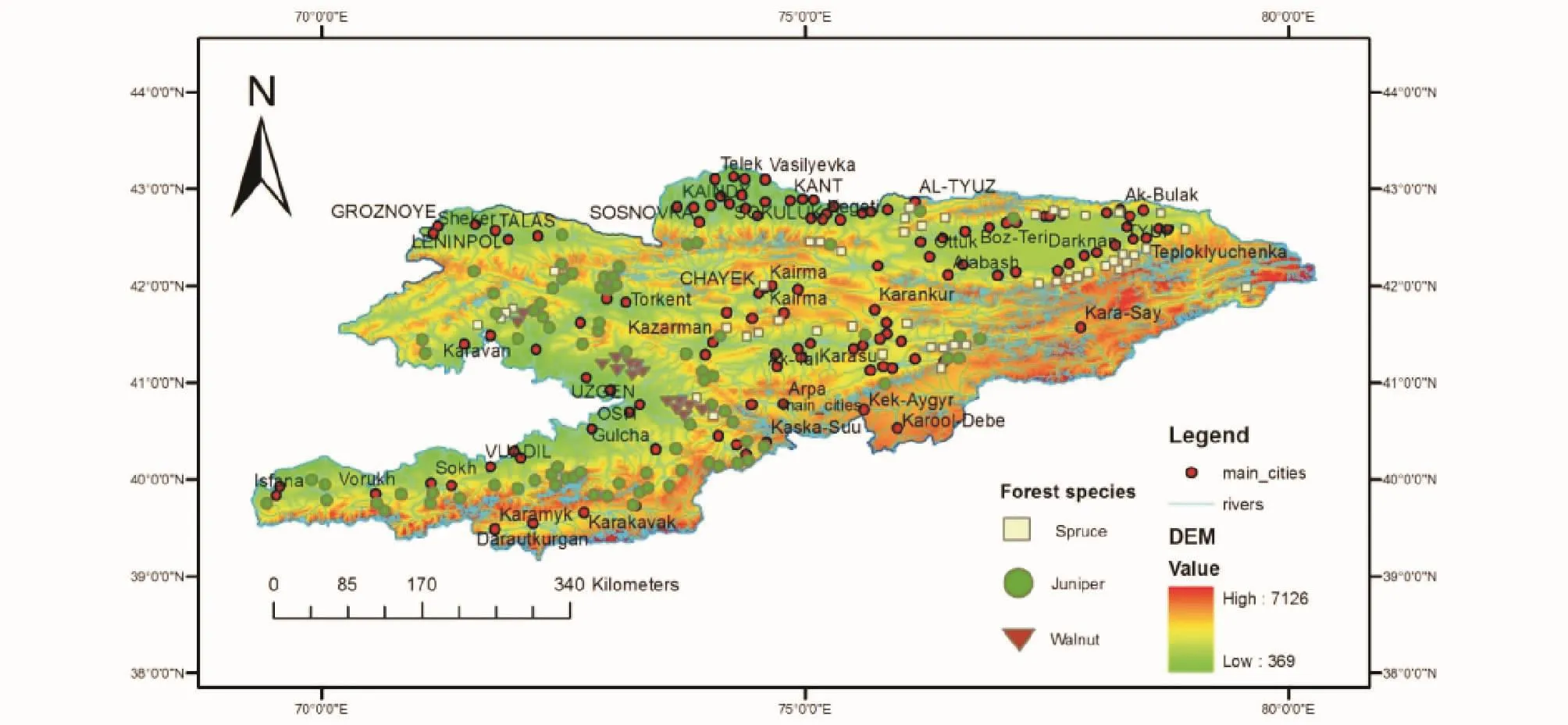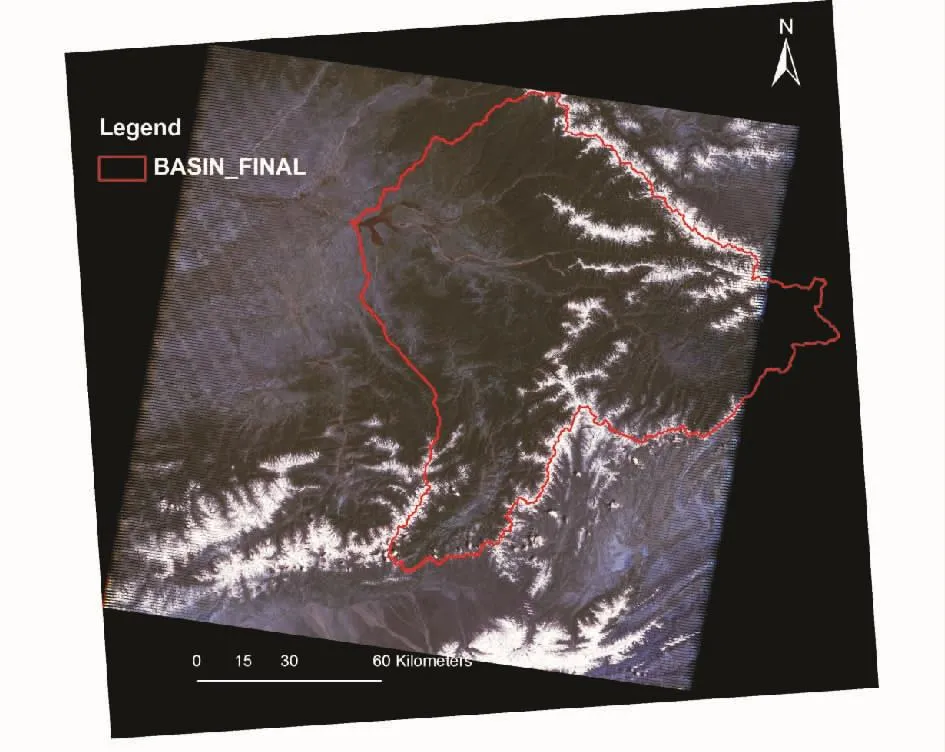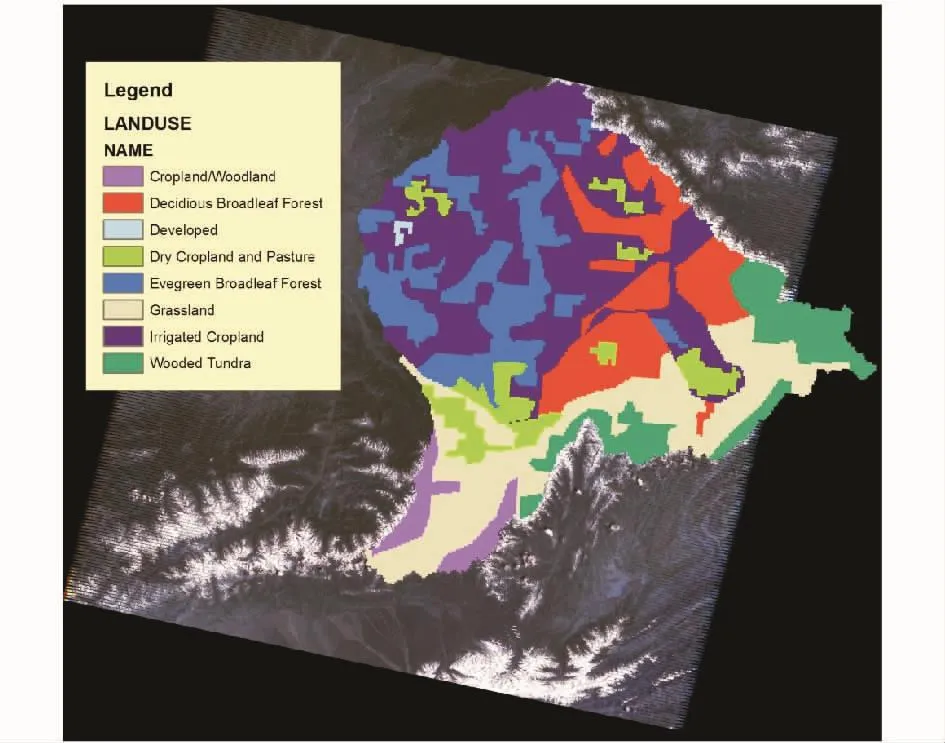Optimum Density and Space Structure of Kyrgyzstan's Juniper Stands for Identifying Water Protective Properties
Zayirbek Toktoraliev,Okke Batelaan,Pichang YUE,Heng ZHANG
1.South Division of National Academy of Sciences,Osh 714018,Kyrgyzstan;2.Department of Hydrology and Hydraulic Engineering,Vrije Universiteit Brussel,Brussel1050,Belgium;3.Institute of Agricultural Economy&Information,Xinjiang Academy of Agricultural Sciences,Urumqi830091,China
1 Introduction
This article presents research results concerning the relationship between density and space structure of juniper stands and their water protective properties for the northern slopes of the Turkestan-Alaimountain chain.There are two exact antipodes of opinion about the impact of forest on precipitation enhancement.The first one says that forest,including mountain forest,enhances the precipitation from 1-3 to 15%-20%in summer period and up to 70-80%in winter period.Examination of precipitation measuring accuracy detects the systematic measuring errors from 3%-12%of liquid precipitation to 16-70%of solid precipitation.According to the second one,the roughness in mountain forest is 10-20 times as much as that in treeless areas.This intensifies the turbulent interaction and restrains the airflows what leads to extra precipitation and entrapment of horizontal precipitation,particularly in the context of high humidity[18-19].Precipitation transfer in juniper stands(precipitation interception by juniper crowns,snow cover distribution and snow melting regime)is an issue of much interest[4-8,14].Forests have an important impact on snow accumulation,snow storage distribution and snow melting regime.The research works implemented in this direction mostly refer to plains;the same investigations related to mountain territories,in particular to juniper biogeoce noses of Kyrgyzstan,have not been carried out so far[3].In mountains it is practically impossible to compare snow storage in the field and forest.Therefore,it is important to compare snow storage under shelter wood and in the nearest glade area;and for total woodland to calculate based on the amounts of these indicators with due consideration of proportion of their areas[1,2,9].A peculiarity is the small number of precipitation events in the first half ofwinter period.The basic mass of snow is accumulated during February-March and snow storage grows to amaximum level;thereby the density of snow cover is not high.These conditions have a specific impact on the snow melting regime of juniper stands.Snow melt intensity is lower in forest than in glade and open areas;however,snow melting is finished earlier here due to small snow storage[10-12].
Thus,protective properties of juniper stands are the extension of the snow melting period,reduction of the intensity of water yield from snow and obstruction of production of snow melt runoff.Juniper forests grow on steep mountainous slopes and in upstream areas where groundwater recharge occurs,they prevent soil erosion by water and wind,formation of mud flows,soil flows,mountain creeps,obstruct rapid snow melting,destructive floods and secure groundwater runoff[15-17].Moreover,forest entraps atmospheric precipitation;there is a relatively little research done on the distribution and interception of precipitation in mountain forests of Kyrgyzstan compared to the plains.The amount of precipitation interception is highly variable during vegetation period since the depth of precipitation is extremely irregular during the year.Water resources of South Kyrgyzstan sustain cross-border water supply as it supports the needs in water throughout the Fergana valley.The water supply plays an important role in maintaining environmental stability in many densely populated areas.However,the river discharge is subject to impact of climatic and anthropogenic changes,which leads to problems of increasing drought and security water as a source for drinking water supply.It also will impact irrigation issues and environmental state of water ecosystems[12,19].
2 Overview of Juniper and Walnut forest ecosystems in Kyrgyzstan
The important challenge of global climate change is the as-sessment of"forest-water"interaction systems;therefore detailed investigation of the"forest-water"system is an important issue of this research work(Fig.1).One of the problems within the"forest-water"system is connected with the threat of a possible reduction of potential snow storage in mountainous areas,which is expected to occur under global warming.The consequence will be a changed hydraulic regime of snow melt and runoff.Climate in mountainous areas is different from the climate in the plains due to their high variability caused by the diversity of the landscape.Characteristic is the higher altitude,the lower temperature of water and soil and the increasing number of precipitation event sup to a certain level,while the vegetation period decreases[13].The main climatic peculiarity in the juniper forests belt is drought in the second half of the vegetation period.The average annual air temperature is4.30℃ and annual amplitude is20℃.The summer is comparatively cool,with June being the warmest month with an average temperature of 14.9℃ and a maximum temperature of29.2℃.The coldest month is January with on average-5.1℃,absolute minimum-22℃.The warmest one is June.

Fig.1 Overview of occurrence of Juniper and Walnut forest ecosystems in Kyrgyzstan
The duration of the frost less season is 180 days on average April-September.Positive average daily temperatures are common from the middle April to the middle October,but cold spells occur frequently in late spring and early autumn.The soilmoisture regime is completely dependent on the intensity of the precipitation distribution during the year.The average annual precipitation is 615 mm,most rainfall is observed in spring and the first half of summer(47%of annual amount).August-September,the second half of vegetation period is the period with minimal precipitation.After September the precipitation increases.The winter precipitation is 26%of the annual amount,and snow cover is observed from November to April and reaches35 cm and rarely up to 70 cm.All rivers originating from themountains flow into valley part of the Nookat region and belong to the Syr-darya river basin.In early spring some of them have manifold flow of temporary streams.The rivers are mainly glacier-and-snow-fed with a water regime that is typical for mountainous regions.The annual discharge regime of the rivers is distinctively divided into two periods:spring-summer floods and autumn-winter low discharges.The start of the flood season changes from year to year depending on the weather conditions of the year.Floods on the rivers of the Turkestan-Alaimountain chain start on average in early April and end in the second half of August.The maximum runoff is usu ally observed in June.Increase of runoff during the flood season depends on the dryness of the year and on average it ranges from 40-70 sm.The minimum runoff is observed in the pre-flood period.
3 Landsat image and land use of southern Kyrgyzstan Kara-darya basin
The data collected during the research allowed to prepare cartographic material.Landsat image demonstrates the state of tree,shrub and grassland vegetation,soil and other conditions(Fig.2,3).This allows using a differentiated approach for assessing natural resources and planning of actions in the investigated zone.

Fig.2 Landsat image of southern Kyrgyzstan Kara-darya basin

Fig.3 Land use of southern Kyrgyzstan Kara-darya basin
Studying the hydraulic peculiarities in the"forest-water"system requiresmodern research methods.Formation of snow cover,interception and distribution of solid precipitation and snow melting regime were defined on the basis of snow survey methods with the use of snow sampler and snow stake since the first permanent snow cover(October)once a month,and during the snow melting period more frequentevery 3-5 days.Interception of liquid precipitation by the crown layer of junipers and shrubs was measured by use of precipitation gauges.The water-protective and water-regulating role of juniper stands is the conservation of soil moisture on the mountain slopes.By preventing formation of overland runoff and its transfer into deeper soil layers,they contribute to moisture accumulation in the soil and its use during the dry part of vegetation period.Also the slope-protective role of juniper stands is significant;it depends on the water and physical characteristics of the soil not only in high-density stands but even in open forests.Juniper forests have the strongest impact through mineralization of forest floor outputs and removal to lower areas by fertilizing soil with soil nutrients elements and improving soil structure.The soil types in the main areas of the juniper stands,which are more concentrated inmiddle-mountain and high-mountain sub belts,are distinguished by higher infiltration capacities compared to the treeless areas which influence the snow melting regime of juniper stands.The duration of the snow melting period depends on the weather conditions and varies from 0.5 to 1.5 month.The snow melting period in juniper stands extends up to 20 days compared to slopes which are treeless.The maximum rate of water loss from snow is balanced what prevents formation of snow melt surface flow.There is no wind-driven snowresed imentation in the belt of juniper forests,even in open forests,what contributes to bedding snow cover and prevents descent of snow slips.This phenomenon is practically not observed when canopy density is already 0.3-0.4.Hence,also juniper stands reduce chance of avalanche formation.All this demonstrates the high adaptability of juniper to arid conditions and significant positive impact of juniper stands on hydraulic regime.
3 Conclusions
Forests play a key role in water resources production.Trees are water consumers but on the other hand they protect soils and increase water productivity.Our findings show that the slope-protective role of juniper stands to a considerable extent depends on the water and physical characteristics of the soil both in close and open forests.Juniper forests have the strongest impact through mineralization of forest floor outputs and removal to lower areas by fertilizing soil with soil nutrients elements and improving soil structure.
Procession of the research results corroborated that soil in the main areas of juniper stands is distinguished by higher infiltration rates compared to treeless areas.Juniper stands have a significant influence on the snow melting regime.Experimental works proved that wind-driven snow resedimentation is not observed in the belt of juniper forests and open forests.In its turn this contributes to proportional snow cover and prevents descent of avalanches.This phenomenon is practically no to bserved when canopy density is already 0.3-0.4.
Thus,conducted researches show that juniper stands of Kyrgyzstan carry out all environment-protective and water-protective functions.Therefore,we conclude that juniper forests adapt to different natural conditions and have a positive impacton the hydraulic regime of mountain ecosystems.
[1]Botman K.S.Penetration of precipitation under shelter wood of juniper forest.-Mag.Forestry,7:44-48.
[2]Botman K.S.Regulating the runoff by various forest areas in small watersheds of mountain-forest belt of the Western Tyan-Shan.-Materials of Union’s session on water-protective role ofmountain forests.Part,Krasnoyarsk,1975:12-14.
[3]Bochkov A.P.Impact of forest and agro-,forest and melioration actions on river flow rate in forest-steppe zone of the USSR’s European part.,L,GIMIZ,1954:136.
[4]Bikirov Sh.B.Koshumbaev P.Multipurposeuse of juniper forests.Vestnik.-Issyk-KulState University,Karakol,2002(6):28-32.
[5]Vipper P.B.Juniper stands of Central Asia as forest vegetations type.Bot.Mag,1953:38.
[6]Gan P.A.,Chub A.V.Juniper stands of Kyrgyzstan,Frunze,1978:56.
[7]Gan P.A.Forest reserve of Kyrgyzstan for last50 yearsand its current state.“Problems of mountain management”.-Frunze,1982:94-115.
[8]Djanaeeva V.M.Juniper in Kyryzstan.-Frunze,1965:112.
[9]Kosmynin A.V.Hydraulic and soil-protective role of juniper forests and sparse forests on the northern slopes of Alaimountain chain.- “Hydraulic investigations in mountain forests of the USSR”,Frunze,1985:120-131.
[10]Kosmynin A.V.Hydraulic and soil-protective role of juniper forests and sparse forests on the northern slopes of Alaimountain chain.- “Hydraulic investigations inmountain forests of the USSR”,Frunze,1988:121.
[11]Kosmynin A.V.,Klavdienko S.I.Some peculiarities of humidity transpiration by juniper stands in southern Tyan-Shan.-Materials of the I Union’s session on juniper issues(Erevan,9-12 December 1975),Erevan,1976:149-154.
[12]Kitredj D.Impactof foreston climate,soil and waterregime.-M.,Nauka,1961:465.
[13]Koval I.P.Quantity-based assessment of water-regulating role of mountain forests.-Materials of Union’s session on water-protective role of mountain forests,Part1,Krasnoyarsk,1975:19-21.
[14]Molchanov A.A.Hydraulic role of forest.-M,1960:497.
[15]Musuraliev T.S.Currentstate of juniper stands in Osh oblast(reportat regional conference of forestry employees,Naukat),1988.
[16]Musuraliev T.S.Juniper forests of Kyrgyzstan.Materials of international symposium.Problems of Juniper Forests.Searching for decisions,ways,methods.-Bishkek,2001:189-191.(in English and Russian)
[17]Mukhamedshin K.D.Juniper stands and sparse for es ts in Southern Kyrgyzstan.-Frunze,1967:248.
[18]Rakhmanov V.V.Water-protective role.M.,1962:326.
[19]Toktoraliev B.A.and others.Report of forest&entomologic group.State Agency of Environmental Protection and Forestry under the KR Government,2009.
 Asian Agricultural Research2014年7期
Asian Agricultural Research2014年7期
- Asian Agricultural Research的其它文章
- A Study on Antibacterial Activity and Chem ical Com position of the Petroleum Ether Extract from Aspergillu sniger Mycelia
- On the Relationship between Duration of Vegetative Grow th Stage of W heat and the Average Daily Temperature
- The Design and Implementation of Black Tea Traceability System Based on UHF RFID
- Innovation of Supervision System for Quality and Safety of Edible Agricultural Products
- Com position,Property Characterization and Application of Agricultural and Forest Biomass Carbon
- The Survey of Ermia mangshanensis Resource in South China Tiger Nature Reserve
